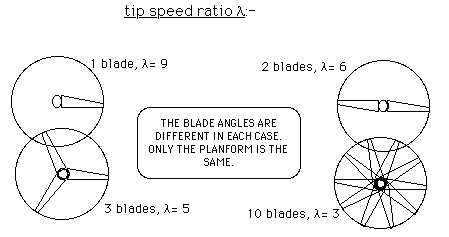tip speed ratio

Four rotors designed to run at different tip speed ratios. Image courtesy Hugh Scoraig .
In reference to a wind energy conversion device's blades, the tip speed ratio is the ratio between the rotational speed of the tip of the blade and the actual velocity of the wind. High efficiency 3-blade-turbines have tip speed ratios of 6–7. On the whole, a high tip speed ratio is better, but not to the point where the machine becomes noisy and highly stressed. The tip speed ratio determines how fast the wind turbine will want to turn and so has implications for the alternator that can be used.
Modern wind turbines are designed to spin at varying speeds. Use of aluminum and composites in their blades has contributed to low rotational inertia, which means that newer wind turbines can accelerate quickly if the winds pick up, keeping the tip speed ratio more nearly constant. Operating closer to their optimal tip speed ratio during energetic gusts of wind allows wind turbines to improve energy capture from sudden gusts that are typical in urban settings.
In contrast, older style wind turbines were designed with heavier steel blades, which have higher inertia, and rotated at speeds governed by the AC frequency of the power lines. The high inertia buffered the changes in rotation speed and thus made power output more stable.
The speed and torque at which a wind turbine rotates must be controlled for several reasons:
Overspeed control is exerted in two main ways: aerodynamic stalling or furling, and mechanical braking. Furling is the preferred method of slowing wind turbines.
